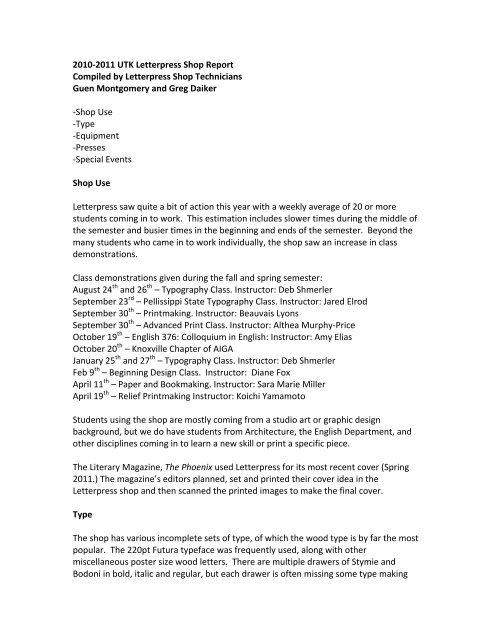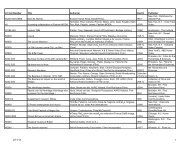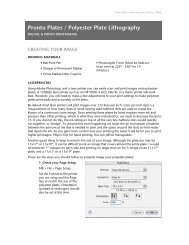2011 UTK Letterpress Report
2011 UTK Letterpress Report
2011 UTK Letterpress Report
You also want an ePaper? Increase the reach of your titles
YUMPU automatically turns print PDFs into web optimized ePapers that Google loves.
2010-‐<strong>2011</strong> <strong>UTK</strong> <strong>Letterpress</strong> Shop <strong>Report</strong><br />
Compiled by <strong>Letterpress</strong> Shop Technicians<br />
Guen Montgomery and Greg Daiker<br />
-‐Shop Use<br />
-‐Type<br />
-‐Equipment<br />
-‐Presses<br />
-‐Special Events<br />
Shop Use<br />
<strong>Letterpress</strong> saw quite a bit of action this year with a weekly average of 20 or more<br />
students coming in to work. This estimation includes slower times during the middle of<br />
the semester and busier times in the beginning and ends of the semester. Beyond the<br />
many students who came in to work individually, the shop saw an increase in class<br />
demonstrations.<br />
Class demonstrations given during the fall and spring semester:<br />
August 24 th and 26 th – Typography Class. Instructor: Deb Shmerler<br />
September 23 rd – Pellissippi State Typography Class. Instructor: Jared Elrod<br />
September 30 th – Printmaking. Instructor: Beauvais Lyons<br />
September 30 th – Advanced Print Class. Instructor: Althea Murphy-‐Price<br />
October 19 th – English 376: Colloquium in English: Instructor: Amy Elias<br />
October 20 th – Knoxville Chapter of AIGA<br />
January 25 th and 27 th – Typography Class. Instructor: Deb Shmerler<br />
Feb 9 th – Beginning Design Class. Instructor: Diane Fox<br />
April 11 th – Paper and Bookmaking. Instructor: Sara Marie Miller<br />
April 19 th – Relief Printmaking Instructor: Koichi Yamamoto<br />
Students using the shop are mostly coming from a studio art or graphic design<br />
background, but we do have students from Architecture, the English Department, and<br />
other disciplines coming in to learn a new skill or print a specific piece.<br />
The Literary Magazine, The Phoenix used <strong>Letterpress</strong> for its most recent cover (Spring<br />
<strong>2011</strong>.) The magazine’s editors planned, set and printed their cover idea in the<br />
<strong>Letterpress</strong> shop and then scanned the printed images to make the final cover.<br />
Type<br />
The shop has various incomplete sets of type, of which the wood type is by far the most<br />
popular. The 220pt Futura typeface was frequently used, along with other<br />
miscellaneous poster size wood letters. There are multiple drawers of Stymie and<br />
Bodoni in bold, italic and regular, but each drawer is often missing some type making
large setting jobs in one typeface difficult. Craw Clarendon is widely available and is also<br />
one of the more complete faces we have. Students frequently ask for Helvetica and<br />
other faces, and also inquire about larger type than we have available in the shop. To<br />
meet these demands, acquiring more complete drawers of type and additional large<br />
wood type sets is recommended.<br />
Equipment<br />
This year, the <strong>Letterpress</strong> shop changed from using oil and acrylic inks to using primarily<br />
rubber-‐based inks. These inks have several advantages and are especially good for a<br />
learning-‐environment shop.<br />
-‐The rubber-‐based ink does have “skins” that form on the inside of an ink can.<br />
-‐ Are easily cleaned up, and do not dry on rollers which are mistakenly left out.<br />
-‐ Come in most colors except for Gold and Silver. For metallic colors, the<br />
letterpress shop is still using oil-‐based ink.<br />
The shop now has the ability to make its own polymer plates. In the beginning of Fall<br />
2010, the letterpress ordered an Aluminum Boxcar Base, Polymer sheets and<br />
adhesive. This allows us to print nearly any digital file on the letterpress.<br />
However at this point there is still a lot of guesswork in making our own polymer<br />
plates. We have not refined our plate-‐making skills down and would like to<br />
establish more exact exposure and washout times. We are currently exposing<br />
the plates on the exposure unit at program 9 and washing out with fairly warm<br />
water for under five minutes. Ideally, this operation requires a machine designed<br />
for this process. Although the purchase of such a machine may be unfeasible at<br />
this moment, the ability to make polymer plates quickly and successfully make it<br />
an important long-‐term investment.<br />
The floor standing corner rounder no longer works. It is easily fixed, but there is<br />
consideration whether we might supply letterpress with smaller, handheld corner<br />
rounder’s and save the floor space.<br />
The shop also contains various tools for cutting leading, and a functional miter saw to<br />
cut leading and lines along an angle, allowing the typesetter to create boxes and other<br />
rectilinear frames.<br />
Presses<br />
The shop’s two presses, the Challenge and Vandercook proofing press are in need of<br />
repair. The Vandercook is in better working shape and although manual, has a self-‐<br />
inking mechanism that can be useful for larger jobs. The Vandercook does not release<br />
the paper when it shifts into “Trip” at the end of the press and is missing some knobs<br />
which adjust the roller height.
As mentioned in last year’s report, the Challenge press is not functioning as an electric<br />
self-‐inking press and recently developed a problem where it is also not tripping, or<br />
raising the printing drum, when the right trip pedal is pressed. This means that students<br />
are printing on the tympan material which then prints on the backs of their paper. Chris<br />
Macado attempted to fix the Challenge early in the Fall semester, but was not able to<br />
keep the self-‐inking mechanism from falling out of gear and clanging. We have not<br />
contacted him about the more recent development with the trip pedal. The Challenge<br />
press is working right now for proofing or demonstrations, but longer jobs are usually<br />
completed on the Vandercook as it is in better working order. The shop would benefit<br />
greatly from adding either a self-‐inking electric press to the working environment or a<br />
table-‐ top platen press for quick production of small-‐dimension jobs.<br />
Special Events<br />
The shop contributed to two special events during the Spring <strong>2011</strong> semester. The first of<br />
which was the Printmaking Open House held on Sunday, March 13 th . For the<br />
Printmaking Open House, the shop collaborated with local poet, R.B. Morris by hand<br />
printing two of his poems, Tsunami and The Deal. R. B then came to the shop during the<br />
open house and recited a selection of his poems, including the two printed poems.<br />
After the reading, he signed and handed out his printed poems to all who attended,<br />
including a pair made out to the letterpress shop. The remainder of the poems where<br />
then given to R.B.<br />
The second special event initiated by the shop was putting together the show, We Press<br />
Letters Better, which took place on April 29 th , <strong>2011</strong> at Gallery 1010. The show consisted<br />
of letterpress posters and artwork incorporating letterpress printing techniques. All the<br />
work in the show was created using the University of Tennessee’s <strong>Letterpress</strong> shop. We<br />
Press Letters Better was a great success and an excellent way to promote the shop to<br />
the general public. <strong>Letterpress</strong> paraphernalia was also incorporated into the show to<br />
spark questions and conversations about the shop and letterpress printing methods.







